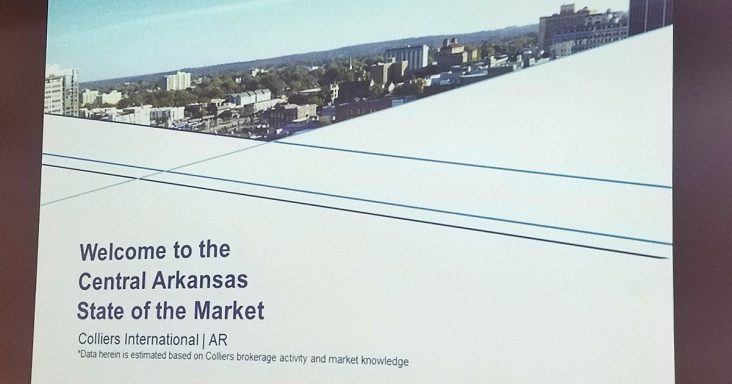Colliers International offers insights on central Arkansas market
by September 29, 2019 12:16 pm 948 views

The ongoing battle between e-commerce and brick-and-mortar retail continues to be the dominant factor in the commercial real estate market.
That was a prevailing theme Thursday (Sept. 26) at a networking and informational event hosted by Little Rock-based Colliers International Arkansas.
Several company principals led the hour-long presentation. They discussed a number of current trends in the central Arkansas market before about 100 people inside the Arkansas Regional Innovation Hub in downtown North Little Rock.
“You need expertise before you do anything in this [commercial real estate] industry,” said Isaac Smith, the president of the state’s largest commercial real estate and property management firm. Colliers also has a Northwest Arkansas office in Rogers. “Whether the information is from Flake and Kelley, whether it’s from Sage [Partners], whether it’s from Colliers. We’re not trying to toot our own horn, but we want to provide the best information to our clients that are shaping the future of our city.”
Using data based on Colliers brokerage activity and market knowledge, Mark Bentley (office), Drew Holbert (industrial) and Todd Rice (retail) offered their views on specific sectors of the market. They’re healthy markets, more or less, with vacancy rates that compare well versus national trends.
Rice said the highly visible retail submarket in central Arkansas has a current vacancy rate of about 4.5% among approximately 44.5 million square feet. The compares favorably to markets in Dallas (4.9%) and Oklahoma City (9.5%).
Discussing the e-commerce/brick-and-mortar phenomenon, Rice said consumers are buying more frequently online rather than in stores, and some retailers are struggling to keep up with the demand. According to data from eMarketer, 6.10% of U.S. retail sales in 2014 were made through an e-commerce channel. Projected U.S. retail sales in 2019 push that number to 12.3%.
Big-box retailers, specifically, are suffering the most as they learn to do more with less, Rice said. Those struggles work their way down to power centers like Shackelford Crossing in west Little Rock and Alcoa Crossing in Bryant. At 14.7%, power centers have the highest retail vacancy rate in central Arkansas, Rice said.
Rice did note an uptick of well-known national companies who have central Arkansas on their development radar, specifically Ruth’s Chris Steakhouse and Topgolf, the wildly popular entertainment chain based in Dallas. Topgolf is scheduled to open its first Arkansas venue in Rogers early next year. Rice said Topgolf representatives were in Little Rock within the past week looking at sites and visiting with city officials. A Topgolf venue in central Arkansas, Rice said, would be an important domino to tall.
“High-end retailers tend to follow each other,” he said.
Colliers tracks about 23 million square feet of office space in Pulaski County and other areas that include Saline and Faulkner counties. Vacancy rates range from 10.3% in Little Rock’s central business district to 11.4% in the suburban markets, Bentley said. Lease rates for Class A office space range from $17.50 to $19.
Bentley referenced a handful of significant deals from the past year that impacted the market, including the $26 million purchase of the former Verizon building at 1 Verizon Drive in Little Rock’s Riverdale area. The Arkansas Development Finance Authority (ADFA) bought the six-story, 303,000-square-foot building. He also mentioned banks that are downsizing their office footprint in downtown Little Rock, specifically Bank of America. Regions Bank is rumored to be mulling a similar move, Bentley said.
Holbert said Colliers tracks about 55 million square feet of industrial space in Pulaski County. Overall the vacancy rate is about 9%. He said industrial flex space properties are about 5% vacancy, with average rental rates of $6.25 per square foot.
